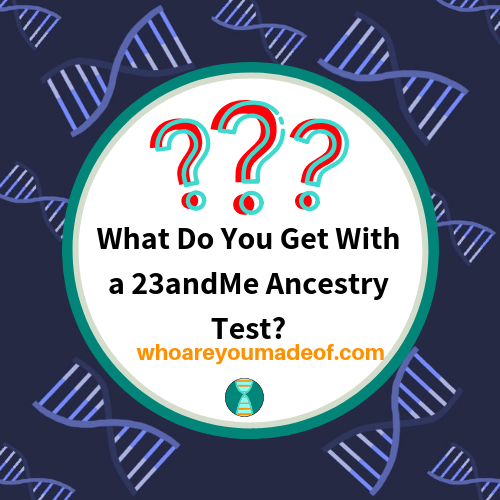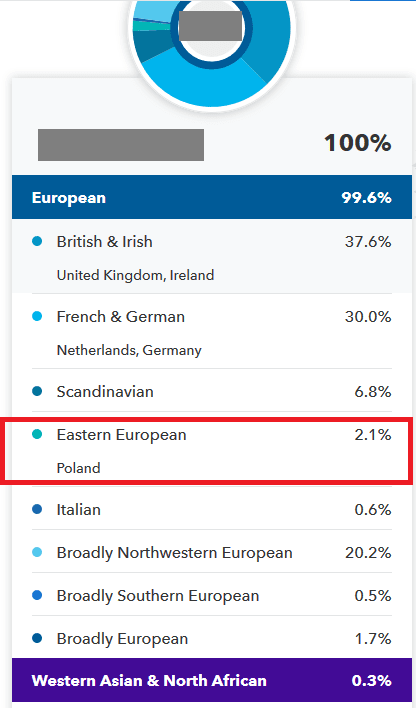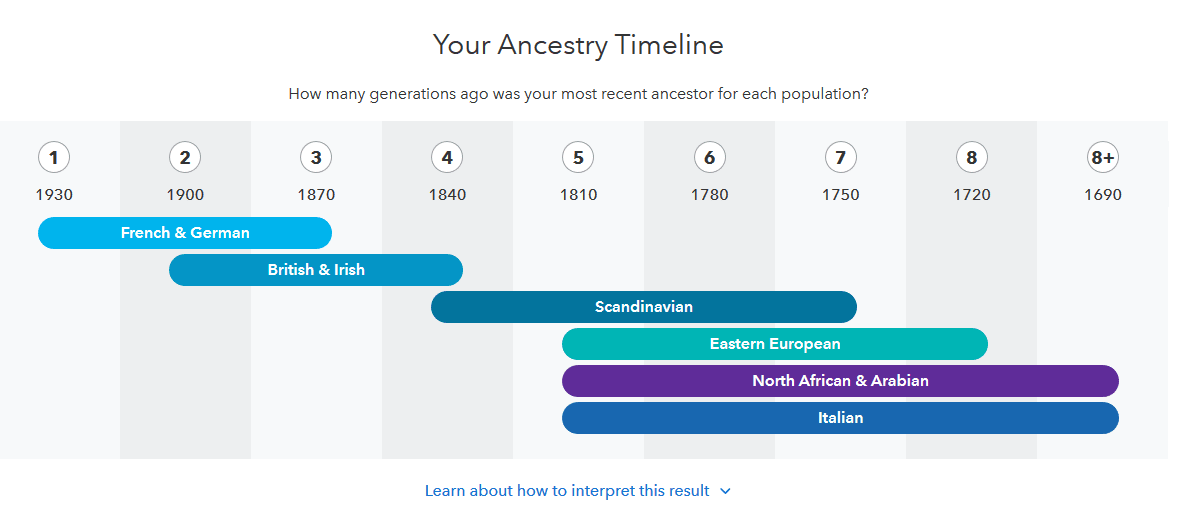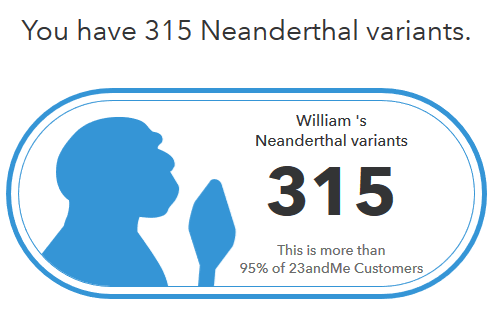Are you curious about what you get with a 23andMe Ancestry test? Whether you are on the fence about which test to get (or whether to get a test at all), or you are waiting for your results, this post will help you understand more about the type of information you can learn from 23andMe results.

Both of my parents recently did the 23andMe Ancestry test, and I decided that this would be a great opportunity to share what I have learned from their results with you. I've been working on my family tree using DNA for years, and so I had really high expectations about what I might be able to learn through their results.
Let's just say that I am really happy with with what I've been able to learn so far. I cover some of my favorite parts of the 23andMe results below.
Note: This post discusses the 23andMe Ancestry service, and does not include information about the health testing service offered by 23andMe.
The 23andMe Ancestry Composition report is informative and fun
One of the most popular aspects of 23andMe DNA results is the ancestry composition report, also referred to as an ethnicity estimate or ancestry estimate. This report can tell you where your family likely lived over the past several hundred years.
I've been working on a theory about my dad's side of the family tree. His paternal grandmother was American, but both of her parents spoke German and reported to be "German" on US Federal Census forms.
Political borders shifted frequently and dramatically in Europe during the last half of the 19th century and the first half of the 20th century, and so it can sometimes make it difficult for us to figure out where our ancestors were really from.
After finding some evidence that my dad's German ancestors were actually ethnic Germans from Poland, I wondered if this would show up on my dad's 23andMe results. In the image below, check out my dad's ethnicity estimate (ancestry composition) from 23andMe - and look carefully at the ancestry region highlighted in the red rectangle:

Poland! My evidence had pointed me in this direction, but I feel so excited to find Polish ancestry on my dad's side of the family.
Another really cool aspect of the 23andMe ancestry composition report is the "Ancestry Timeline", which can help you visualize where the ancestors that contributed DNA from various regions might have come into your family tree.
Again, from my dad's results (thanks for agreeing to me sharing your results, dad!)

With 23andMe you get DNA matches
You may not know this about me, especially if this is the first post on this site that you've read, but DNA matches are my favorite part of DNA results. I check my results and those of my family members very regularly, since DNA matches are the best way to explore and build a family tree.
My parent's' DNA match lists didn't disappoint me at all. My dad's looked as expected, but my mom had a brand-new close relative We were able to connect and determine how we are related, within only a few hours. So amazing!
This brings up an important point that I want to mention in reference to 23andMe DNA results and any other type of DNA test that provides DNA matches. You might get matches that surprise you, and it's important to keep this in mind before you do a test.
DNA match lists are basically never wrong and can be a great way to learn about our family tree. Our DNA matches can give us insight on our ancestors and our living DNA relatives.
Want to know how much neanderthal DNA you have?
This was one of the most entertaining aspects of my parents' DNA results. When they found out that they were going to be able to determine how much neanderthal DNA each of them has, there are a lot of joking about which of them had more.
My mom insisted that my dad was likely the most neanderthal of the couple. And she was right!
23andMe tests your DNA for more than 2,000 variants that are known to have origins in Neanderthal populations. The commonly accepted understanding is that Neanderthals became extinct about 40,000 years ago.
I've always preferred to assume that they didn't really go extinct- If they did, why do most of us of us have at least some Neanderthal DNA in our genes? I'm not the only one who thinks that (check out the last line in this article) .
Interbreeding with modern humans allowed Neanderthal DNA to survive until today- and there is no sign it is going anywhere soon.
Anyhow, for those who are interested in learning how many variants from Neanderthals are still visible in your genome, 23andMe can help. Check out my dad's Neanderthal variants:

What's the significance of having, or not having neanderthal DNA? It's definitely not important one way or the other.
23andMe has a chromosome browser
One of the most useful aspects of the 23andMe results is that you can compare your DNA with the DNA of your matches at the chromosome level using a chromosome browser available on the site. You can see exactly where your shared DNA segments are located, how big they are, and on which chromosomes they sit.
While it sounds technical and even kind of nerdy, it's actually super useful information, especially if you really want to take advantage of using your DNA results to research your family tree. Plus, it's not as hard to use as it might sound.
23andMe gives you your mtDNA and Y DNA haplogroups
Are you interested in tracing your male line back to your most ancient roots? Do you want to know where your maternal line would lead you if you followed your mother's mother's mother's line back as far as you could?
DNA testing companies are able to do this through a special kind of analysis that only tests Y-DNA (only males have this) and mitochondrial DNA (both males and females have this type of DNA)
The information obtained from Y DNA and mtDNA (mitochondrial, abbreviated) results can't really be used for genealogy purposes, except in very limited circumstances. Even so, it's kind of cool to really know for sure where a small percentage of your ancestors really came from, since the science behind this type of testing is considered to be very accurate.
How to get a 23andMe DNA ancestry test
Are you ready to get started on your own DNA testing adventure with 23andMe? Amazing!
I'm sure that you will be happy with what you learn, and you can always check back with my website once you get your results back if you have any questions or need help understanding an aspect of your results.
You can get your 23andMe kit using the link below.
Conclusion
I've only had my parents DNA results for a few days and I am already very excited about all that I have been able to learn. I hope that this post has given you some understanding of what your 23andMe results might look like, and how helpful they will be in exploring your family's heritage.
If you have any questions about something that you read in this post, or if you would like to share your experience testing with 23andMe, I would love to hear from you in the discussion below.
Thanks for stopping by today!


Lisa
Saturday 25th of December 2021
I have been trying to get my parents to ALSO do a DNA test. I am guessing that their DNA will provide even more details and further reach back then just mine. What might the benefits be of my parents ALSO completing a DNA test - they argue that my test defines their history - so what is there to gain. Any ideas?
Why Did Your 23andMe Results Change? - Who are You Made Of?
Friday 30th of October 2020
[…] will update your Ancestry Composition report, the estimate that describes where many of your ancestors may have lived, on a regular basis. The […]